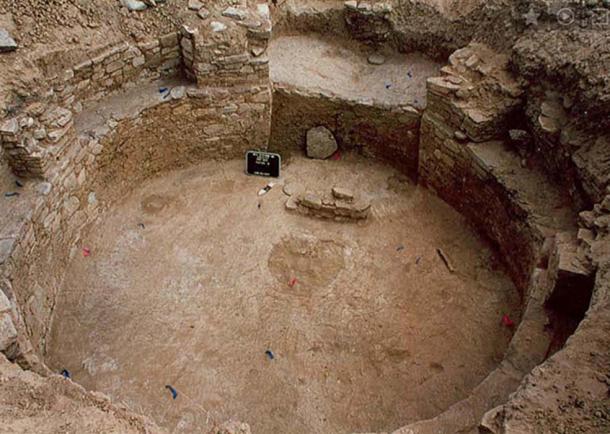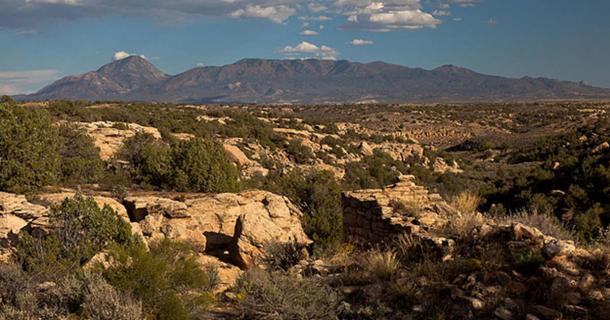Cowboy Wash is a large flat plain beneath the Sleeping Ute Mountain. The village that inhabited this area was probably Anasazi. In 1993, a series of archeological sites were found on the plains, each site featuring one to three pit-houses (a pit-house is a building constructed over a hole in the ground and are commonly referred to as dugouts). The remains that were deemed possibly cannibalistic were discovered by a Ute Tribe- supervised archaeological survey commission on behalf of a private firm that was seeking to launch a new irrigation system in the area. Of the many sites of interest found, 5mt10010 caused the most alarm. It is believed that the dwelling, which was composed of three pit-houses, was occupied sometime between 1125 and 1150 by 15 to 20 people. Inside, “archeologists found more than 1,100 bones and bone fragments, including shoulder blades, skulls, vertebrae, ribs, arm bones, hand and foot bones, and teeth. Nearly all were broken” (Dold, 1998). Many of the larger bones were missing.

A pit house at Cowboy Wash, Colorado. Credit: Bill Brown
All told there were perhaps 21 pit-houses were found at Cowboy wash, the majority of which were used as shelter from the elements or possibly to store food. At site 5mt10010, however, the remains of 12 human bodies were found. Five were buried in the traditional manner. However, seven were piles of bones that exhibited signs of cannibalism. A 1997 report from the Archeological Institute of America describes the state of the findings vividly:
“The remains of 12 people were discovered at the site, designated 5MT10010, but only five were from burials. The other seven appear to have been systematically dismembered, defleshed, their bones battered, and in some cases burned or stewed, leaving them in the same condition as bones of animals used for food. Cut marks, fractures, and other stone-tool scars were present on the bones, and the light color of some suggests stewing. Patterns of burning indicate that many were exposed to flame while still covered with flesh, which is what would be expected after cooking over a fire.” (Walker, 1997)
Debate still rages over whether or not the initial leap to the conclusion of cannibalism is valid, especially among members of the Native American community. There are isolated instances of the consumption of human flesh throughout the area, perhaps 30 sites ranging over many years. Yet these are all individual instances that seem to suggest acts of desperation. The remains found at Cowboy Wash appear, in the words of Discover Magazine, like “an act of prehistoric terrorism” (Dold, 1998).
Patricia Lambert is a bioarcheologist from Utah State University in Logan who worked to reconstruct the fragments into whole bodies. She theorizes that remains found on site 5MT10010 belong to three adult males, one adult female, and three children ranging in age from seven to 14. The bones had the same markings as the ancient remains of butchered animals.
“I found cut marks at muscle attachment sites, such as where the femur is attached to the hip bone,” said Lambert. “It’s pretty clear they were disarticulating the body, cutting tendons and soft tissues that connect various parts. The cut marks occur when cutting tools slip and strike bone instead of tissue and they cannot be mistaken for the gnawing marks an animal might leave.
Moreover, Lambert continues, “If the flesh had been left to rot away rather than being deliberately removed the bones would be discolored and pitted instead of white, smooth, and dense.”
“I can’t say that they were eating these people, but they were certainly processing them in a way that suggests they were,” concludes Lambert.
Also at the site were found many stone tools, pots, jewelry, and other ancient human possessions – all of which suggests that the dwelling was abandoned suddenly. The pit-houses then appear to have been undisturbed until they were rediscovered in 1997.

View down Little Ruins Canon with Sleeping Ute Mountain in the background (CC by SA 2.0 / Greg Willis)
“The evidence,” said archeologist Brian Billman “all points to an outbreak of cannibalism designed to terrorize and intimidate a group of people, most likely some foreigners who posed competition for scarce food resources…. We think that certain groups in the Mesa Verde area, out of desperation, then turned to a strategy of warfare and cannibalism.” Certainly, at least one of the Anasazi groups decided on this strategy to discourage newcomers from the area. The fact that the bones were irreverently scattered about dwellings suggests that the act was meant to send a message to anyone else considering moving to the area. It also could have been part of an ancient ritual to ward off the evil spirits that could have been causing the immigration crisis or drought.
All told, as many as 100 people may have lived in the Cowboy Wash community. Dwellings in the area are still under archeological review and many experts expect more cannibalized remains to turn up. By 1200, researchers believe the severe drought passed and social conditions returned to normal.

No comments:
Post a Comment